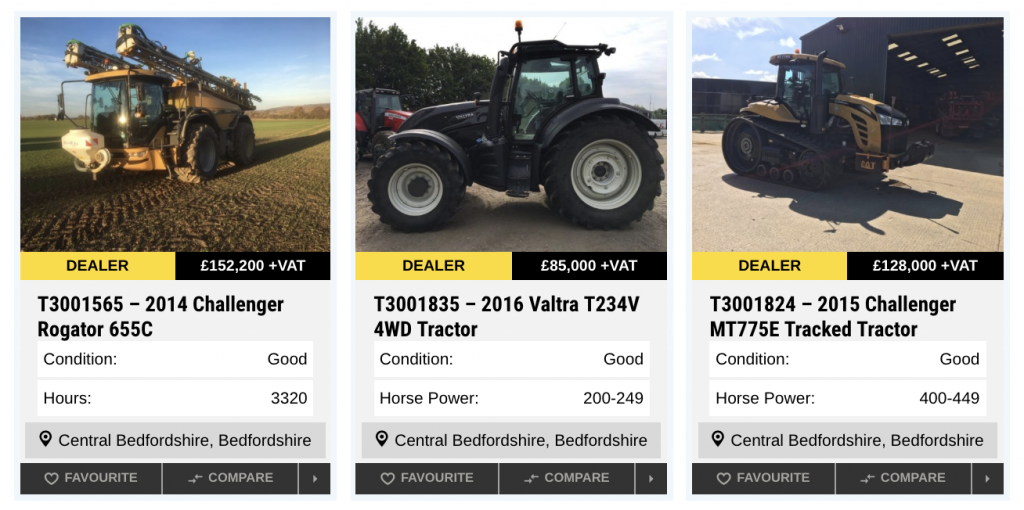Knight Farm Machinery is launching the TopTill – a new seedbed finishing cultivator – which will receive its first public demonstration at the Tillage 2019 event at Deenesthorpe Airfield, near Corby, Northamptonshire, on September 4th.
The implement can be used to work down and finish any style of cultivation, including over-wintered ploughing, and leave it ready for drilling with no further work required.
It features leading paddles running ahead of a front roller, which prepares the seedbed for the cultivating tines, with a final finish being applied by a double CrossKill roller. The machine uses a similar design of frame to Knight’s successful M-Series cultivator.
All the working elements are mounted on independently floating sub-frames, with the cultivating tines mounted on an additional frame so their working depth can be adjusted separately.
The leading element is a row of sprung panels that loosen and break up the soil surface, breaking up clods so that the following roller can crush them and press them into the seedbed.
This creates a levelled and consolidated surface into which the five rows of tines can work efficiently, achieving a thorough soil and trash mixing operation, before the seedbed is finished by the double CrossKill roller.
Key to the machine’s effectiveness is the spacing of the working tines. These are set in five rows, with a 30cm gap front to back between the rows and a 45cm gap between tines on the same row, an arrangement that minimises blockage risks.
This means that – in work – there is a 9cm gap between tines, so the machine can work very shallow and still move all the soil in either a chitting or seedbed preparation pass. The tines are fitted with reversible points to offer extended working life.
The weight of the machine (800kgs/metre depending on specification) is carried on the front and rear rollers, with the working depth of the paddles and tines being adjusted via turnbuckles.
Operators have the option to raise the front of the machine slightly if they want to perform a progressive cultivation.
For transport the machine is carried on two rear wheels, which lift completely clear of the soil when in work. Knight intends to offer a set of tractor wheel-mark eradicators – to run ahead of the levelling paddles – so users can leave the seedbed with no wheel marks on it at all.
The machine is currently available in a six metre format, which needs 150hp – 200hp according to soil type and working conditions.
Case IH Axial-Flow combine harvesters and headers will feature a number of updates from next year, including a new 8.5 metre header, specifically designed for Controlled Traffic Farming. Other features include a new crop lifter design for grain headers, and a new LED lighting package for combines.
The new 8.5 metre Varicut header has been launched to cater for traffic-controlled operations, based on an 8-metre system. It will use the frame of the existing 7.5 metre header, extended to 8.5 metres to save weight, with an actual cutting width of 8.5 metres, to ensure a true and repeatable 8m cut for an 8m controlled traffic system. The working width will be 8.53 metres (28’) and offer all the same features and benefits as the other Varicut models.
The mid-year 2020 grain headers will also feature a new crop lifter, which has been designed to reduce losses by utilising a higher lifting profile to better lift lodged crop up to the cutter bar. To help improve wear resistance, the new crop lifters will also feature a wave formed skid.
Meanwhile, the Axial-Flow combines will offer a new LED light package, including LED row finder lights for safer harvesting at night.
Combines manufactured from February 2020 will meet Stage V Emission Regulation for the EU region. There will be new model numbering for the mid-range combine series with the ‘140 series’ combine range changing to the ‘150 series’, to reflect the move to Stage V Engines. The 7150 model will also feature increased engine power, moving from a rated boost power of 402hp to 413hp, with a peak power of 453hp compared to its current power of 442hp.
Ahead of Agritechnica later this year, Kuhn has displayed its 2020 product line-up to agricultural press at its test farm in France.
The launch event included approximately 30 new models from all product areas, many of which were shown for the first time and others which had been displayed at the French Sima show earlier this year. The Kuhn Smart-Ploughing System, which reduces headland triangles and double inversion, was a definite highlight of the event.
See the Farmers Guide Sept ’19 issue for comprehensive product report.
A quarter of UK farmers have made changes to their spraying operations to get better performance from pre-emergence herbicide applications.
Heeding the advice and results of the Syngenta #lowslowcovered campaign, over 90% now spray at less than 12 km/hr and 84% have increased spray water volume, to at least 150 l/ha, according to results of a series of surveys at farmers’ and operators’ events over the past year.
Syngenta eastern counties application specialist, Harry Fordham, commented: “Most farmers were aware of the Go Low; Go Slow; Get Covered campaign, which focusses attention on fine-tuning application techniques to achieve consistent grass weed control.
“Results of application trials on the Barton Black-grass Focus Site have repeatedly shown that spraying at 12 km/hr or less and maintaining a level boom at 50 cm above the surface achieves better results with any pre-emergence herbicide application.”
Using higher water volume, ideally at 200 l/ha, has also been shown to achieve more consistent results.
“The survey of farmers’ actions highlights the move to higher water rates, and the reports have all seen improvements in grassweed control. The challenge is sprayer efficiency at higher water volume, but there are lots of measures we are looking to share that can help to achieve it,” he advised
Furthermore, the trials have shown that new 90% Drift Reduction Technology (DRT) nozzles can reliably achieve optimum high levels of grass weed control in all conditions.
“Managing drift is a key component of effective pre-em application,” advocated Harry. “Results of new trials, where wind speed was measured at the time of application, has demonstrated the variability of effects on weed control caused by gusty wind moving the spray pattern along the boom.
“Even on a good spray day, with average wind speed of 1.6 m/s, there were gusts of between 0.5 to 8 m/s. Using 90% DRT helped to better mainatin pre-em sprays on target, for more consistent results.”
Over 24,000 Teejet 90% DRT nozzles have been sold in the past two years under the Syngenta Nozzle Offer. That’s sufficient to refit 1500 30-metre sprayers, capable of covering 750,000 hectares of pre-emergence application.
VIEW FARMADS SPRAYERS HERE
Month : 1,446 Units +7.3% change (compared with July 2018)
Year to Date: 7,643 Units -3.0% change (compared with January-July 2018)
The month-on-month volatility of UK agricultural tractor registrations continued in July. The number of machines (over 50hp) registered during the month was 7% up on July 2018, at 1,446 units. This rise followed two months of significant declines and the total for the year to date remains 3% down on the first seven months last year, with 7,643 tractors registered. Some volatility was to be expected this year, given the ongoing influence of Brexit on the market.

Losses to British farmers from theft hit a seven-year high of £50m in 2018, according to NFU Mutual.
A 26% rise in claims for stolen farm vehicles, such as tractors and quad-bikes, to £7.4m last year, was behind the overall increase.
Animal theft claims rose 3.7% to £2.5m in 2018, the company said.
Tim Price, from the NFU Mutual, said: “Farmers and country people are suffering from high levels of anxiety due to repeated thefts by gangs who take advantage of farms’ isolated locations to steal machinery, raid tool stores and even butcher sheep in the fields.
“In a single generation, country people have seen rural crime change from the opportunist theft of a single lamb, to brazen heists of tractors worth over £100,000 and rustlers stealing hundreds of sheep,” Mr Price added.
In July last year, when Leicestershire dairy farmer Jimmy and Esther Pritt were on holiday, a relief worker called to say their Collie-x-Huntaway work dog Rabbit was missing.
Mrs Pritt believes Rabbit, who they valued at between £4,000 and £5,000, was “a rare dog in that she would work for anybody, rustle sheep or cattle, work day or night. From a commercial point of view, she was very, very valuable”.
“It was like a family member was taken,” Mrs Pritt added.
The Pritts have since increased security across their farm following the loss of their farm dog, altering their entrance gates and welcoming a guard dog to their property.
NFU Mutual said some rural communities feel “under siege” by repeated crime activity, but are turning to technology to increase security in their sometimes-isolated locations.
The insurer pointed to innovations such as geo-fencing, which triggers an alarm if tractors go beyond farm boundaries, and livestock marking which puts thousands of micro-dots into their animals’ fleeces, as technology which can help farmers.
“While the rise in the cost of rural theft is a huge disappointment, we are convinced it would be much higher without the investment in rural security by thousands of farmers and higher commitment from many police forces to fighting rural crime,” said Mr Price.
Source – BBC news
Brushcutters have a busy life on many UK farms and estates playing a vital part in keeping grass and weed growth under control. Sales of battery-powered models are increasing and Farmers Guide arranged an on-farm test of a petrol model and an equivalent electric version to see how they compared. David Williams reports.
Not long ago battery-powered strimmers were considered a novelty and a last resort for professional users, often selected only when lower operating noise was essential or for domestic users where storing petrol was an issue. Now, in common with other electric tools, improved battery power, capacity, and extended working times have made them a practical alternative and agricultural dealers report that a gradual changeover from petrol to electric powered models is in progress.
Farmers Guide asked Stihl to supply its most popular petrol model for farm tasks, along with an equivalent battery-powered model to compare, and lent both for a three-week test with Euston Estate on the Norfolk-Suffolk border.
Euston Estate is home to the 12th Duke of Grafton and his family and, along with extensive parkland as well as 28ha of gardens, there is a large farming enterprise including woodland, stewardship grassland, arable crops and a vegetable enterprise run in conjunction with RG Abrey Farms. There is an award-winning solar energy installation and an anaerobic digester for which maize is grown. Livestock include cattle, horses, pigs, sheep and poultry and with all the enterprises across more than 4,300ha there is plenty of work for the maintenance and groundcare team.
The brushcutters recommended by Stihl were FS111 petrol, and FSA130 battery models.
Ideal test user
Jamie Fairs is a member of Euston’s gardening and maintenance team and is well used to working with a variety of brushcutters. As well as keeping paths and tracks clear of grass and brambles, and trimming areas which can’t be reached by tractor-mounted mower, his work includes maintaining verges and other grass areas around Euston village.
“I was very open-minded about the battery-powered version,” he explained. “Stihl is a respected manufacturer and I was quite confident that the electric model would be capable of professional use, but to what extent it could compete with a petrol machine I wasn’t so sure. I was fairly certain the battery model would be nicer to use with less noise and vibration.”
The FS111 petrol model was equipped with a Stihl AutoCut head which holds a reel of nylon line and automatically feeds out a set length each time the release button is knocked on the floor.
The FSA130 had a Stihl PolyCut head designed for trimming larger areas and which has three solid pivot-mounted plastic blades.
For the test Stihl supplied a backpack-type AR1000 battery. This is lithium-ion, incorporates a 6-led battery charge indicator and comes with a handle and waterproof cover. It’s comfortable and with the harness correctly adjusted you forget you have it on,” Jamie said. “It’s easy to take on and off and even though we had a week of exceptionally hot weather during the test period, wearing it was never a problem.”
Jamie said that because battery-powered brushcutters consume no power unless they are cutting, all the battery capacity is available for work. “This extends on-site time between recharging where petrol models are usually left idling for brief periods between use and continue to consume fuel,” he explained. “It also helps that with no clutch, the battery model can operate at lower engine revs for lighter work and there are three power settings allowing the user to reduce the operating power and speed for lighter tasks – maximising available working time, and reducing working noise.”
Adequate capacity
The battery supplied was the smallest of Stihl’s three backpack versions but still achieved approximately 90 minutes of cutting time at full power, equivalent to several hours’ typical use. Jamie said that charging overnight and again at lunchtime meant there was plenty of capacity for a typical day’s trimming although for continuous heavy work a larger battery or a spare would have been helpful.
The FS111 achieved approximately one hour’s work at full speed between refuelling, which Jamie deemed excellent in terms of fuel economy. “It’s got a very large fuel filler,” he said. “It’s much easier to access than any of our current brushcutters making it easy to refuel at the work site and it’ a great design feature. One of the best I have seen.”
For convenience; simply pressing the safety switch and pulling the trigger of the battery model was unbeatable, but that didn’t stop Jamie complimenting the ease of use of the petrol version. “Even after running out of fuel, whether hot or cold it started easily after a press of the fuel pump and was never any trouble.”
Use and maintenance
In work, the petrol model proved comfortable, quiet compared to the estate’s current machines and easy to use but Jamie said the electric version was quieter and more comfortable being almost totally free of vibration. He pointed out that whereas the petrol model continues to idle between cutting periods so there is always some noise, the battery version became silent when not cutting which made it less tiring.
“Both were well balanced and even with the lighter electric motor at the top, the position and angle of the cutting head was easy to control. One thing I noticed was that after a long period of use I was less physically tired as less effort was required swinging it from side to side. “
Apart from recharging the battery model requires little maintenance but the petrol machine was simple to prepare for a day’s work. “Everything is well designed and accessible,” he said, “and a feature I particularly liked was the transparent fuel tank making it easy to check the fuel level at a glance.
“The AutoCut head is easy to reload with line but there is plenty of capacity and even though it is lighter than the line we usually buy, it wasn’t refilled during a week’s heavy use.”
The electric model’s PolyCut head was liked by all the operators who found it effective and easy to use. Refilling was especially easy. “It’s very good on green vegetation,” said Jamie, “but we found quite quickly that it didn’t like tree stumps or walls so had to be careful where there were obstructions. We tried the cord head too, but found this was the one situation where the power wasn’t quite as good as the petrol machine and it struggled when presented with dense vegetation.”
Verdict
Jamie said that by the end of the test he favoured the FSA130 battery model over the petrol, tending to use this from the start of each working period until the battery was flat, and then switch to the petrol. “I got on well with both and would be happy working with either, but the battery version was quieter, more convenient and more comfortable due to the lower vibration and I was very impressed. The petrol performed well too, and had a very slight power advantage for the heaviest work, so having it as a reserve worked well.”
Asked whether he would request a battery model when the estate’s brushcutters are next updated Jamie confirmed that he would, but with a higher capacity battery. “The battery life was impressive,” he said, “but during the final 20 minutes of working it was obvious without looking at the battery indicators that a recharge was needed.”
The opening of Agco main dealer Chandlers new Country Store at its Shefford, Beds depot was celebrated in late June.
This brings the number of Chandlers Country Stores to seven, each of which is based at its agricultural machinery depots. These have proved extremely popular with the dealer’s agricultural customers as well as the general public since the first opened at its Belton, Lincs depot in 1990 and the selection of products on offer has increased steadily responding to customer demand.
“We supply a wide range of rural, pet and equine products to suit our local customers, including, dog and cat feed, small holder feed ranges, equine products for the rider and horse – along with Country Clothing and boots, power tools from Milwaukie, powered garden tools and mowers from Honda & Stihl and much much more. It’s said that we well everything from a ‘tin tack to a tractor’, explained Chandlers (Farm Equipment Ltd) managing director Gavin Pell.
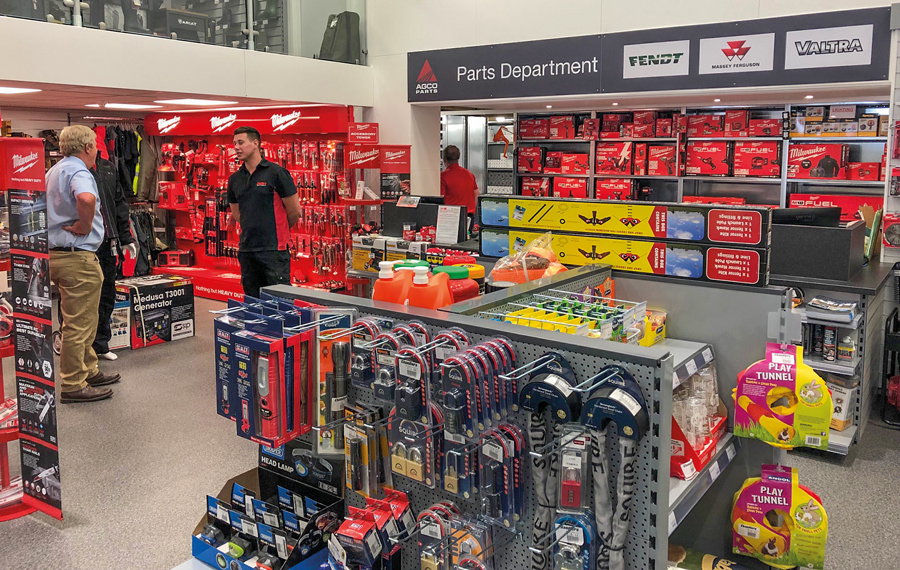
The new Country Store includes plenty of showroom space for farm supplies and sundries, spare parts, and workshop and maintenance equipment.
“The new Country Store is approximately six miles west of Biggleswade and serves customers from Biggleswade to Hitchin. Our very successful opening event on Saturday 22nd June attracted more than 200 customers for a day of family fun, and included free tea and cake and we were joined in the evening by our local farming customers for a hog roast and VIP tour of the redeveloped depot and new Country Stores.”
The site at Chicksands, Shefford has been extensively redeveloped since Chandlers opened its depot there in 2014 including brand new 5,000ft2 agricultural workshops adjacent to the original site, along with refurbished offices a larger parts department and yard.
“We offer same day delivery of stock throughout our network of Country Stores and look forward to serving the rural community of Beds, Herts and Bucks from Chandlers Shefford,” added Gavin.
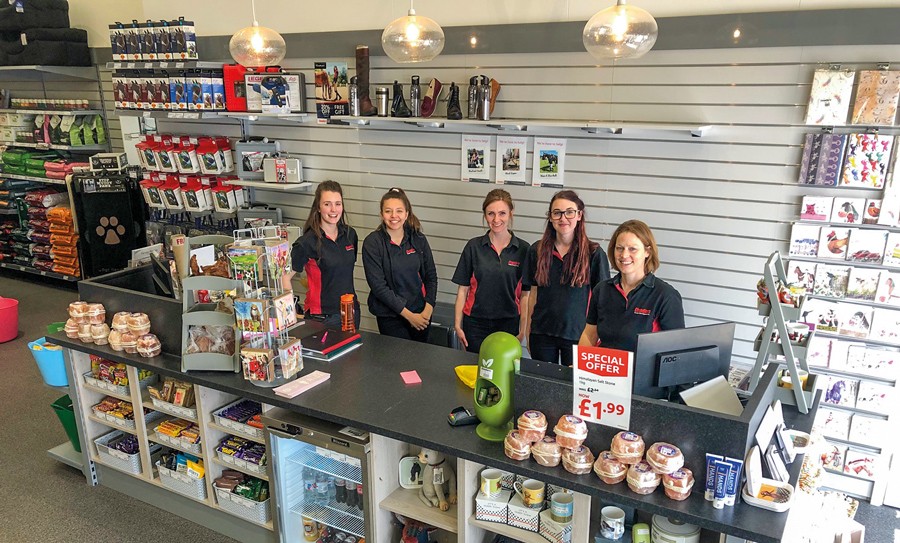
Pictured at the official opening are (l-r) senior Country Store shop assistant Niamh Randall; Country Store shop Assistant Nicol Green; group assistant Country Stores manager Sammi Laboure; Country Store shop assistant Ciara Walker and group Country Stores manager Felicity Hart.
CLICK HERE TO VIEW USED FARM MACHINERY FROM CHANDLERS
More than 5,000 trailers have now been inspected and certified as being in roadworthy condition through the Tilly Trailer initiative. Clemmie Gleeson reports.
The scheme calls for all farm trailers to undergo an annual 18-point inspection by qualified land-based engineers to ensure their safety.
The initiative was launched by Jane Gurney and her family following the death of her son Harry Christian-Allan who was tragically killed in 2014 when the tractor and trailer he was driving crashed into a bridge. The trailer was later found to be poorly maintained and the brakes were faulty.
The Tilly 18-point inspection profile was developed in conjunction with the Health and Safety Executive (HSE) and BCH Road Traffic Policing unit. It is intended for trailers capable of carrying loads of 10t and over although it can be applied to any braked items typically found on a farm.
A Tilly inspection is carried out on the farm allowing the opportunity for every trailer to be inspected to the Tilly standard by an authorised mechanic either working within a larger dealership or independently.
One key characteristic of the inspection is that all wheels are removed to allow the brakes to be fully assessed. “It is the only way to really know your machine,” said Jane. Another checkpoint is the towing eye, she added. “The towing eye is what keeps your rig together. If there is more than 10 per cent wear or it has changed shape it should be replaced not repaired.”
Trailers that pass the test are given a ‘Tilly pass’ sticker certificate to be displayed on the trailer’s tailgate. The 2019 Tilly is red and white but the colour will change each year. The inspection is recorded in detail on a uniquely numbered maintenance sheet which includes the certificate number and chassis number. This record is retained in triplicate with copies for the farmer and mechanic and the third copy being returned and retained by Tilly Pass where a hard copy is stored and the details are also entered on a database.

The tragic death of Harry Christian-Allan prompted his mother Jane Gurney to investigate trailer safety and ultimately to launch the Tilly scheme.
Exceeded target
The Tilly scheme launched in April 2018 and Jane told Farmers Guide that she initially set a target of having 100 trailers inspected by the following autumn. However that target was exceeded ten-fold and in July this number reached 5,050.
“We have had tremendous support from trailer manufacturers,” said Jane. “By the autumn we will have a total of 250 outlets including dealerships and independent land-based engineers signed up to the scheme.”
Another success was two-days’ training which was attended by 150 police officers from 14 different forces which covered trailer safety and what officers should look for.
“At the moment it is law to properly maintain and check your trailers but it is not law for someone to check you are doing it,” she added. She was hopeful this would change in the future and that the Trailer and Towing Safety All Party Parliamentary Group launched in April this year would ‘move things forward’.
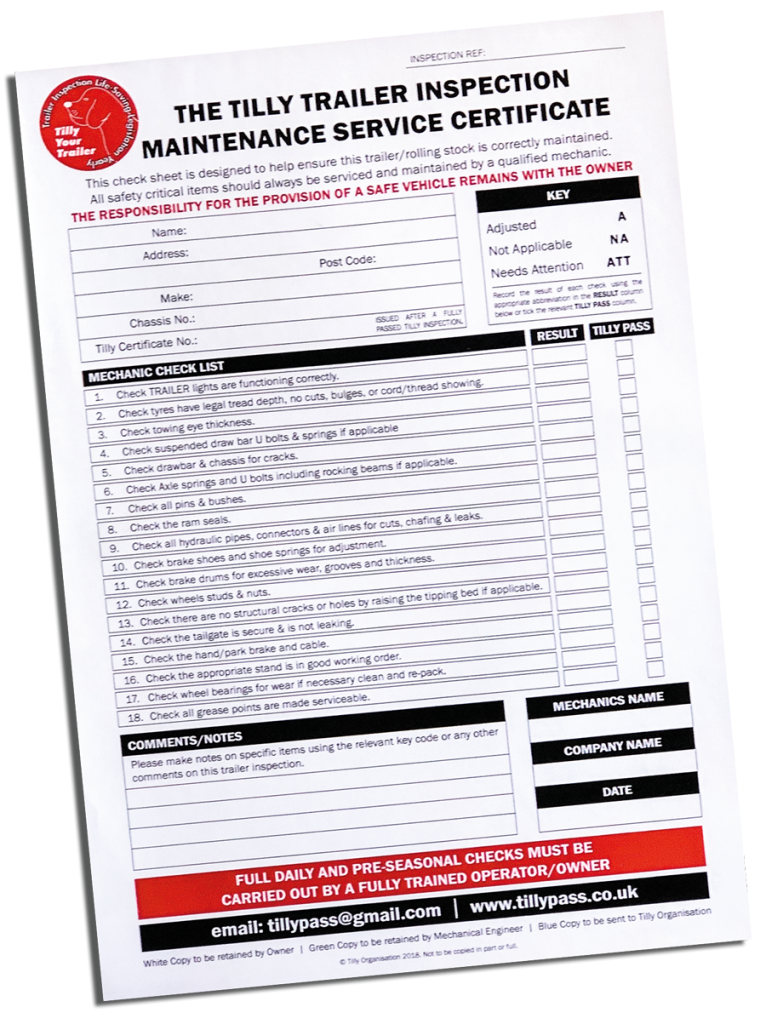
Ahead of Agritechnica later this year Fendt displayed its latest innovations to press from across Europe at the company’s German headquarters. David Williams attended.
Considerable investment in research and development should ensure Fendt’s products and services remain at the cutting edge of agricultural technology. This year an estimated €73.7m will be spent on R&D, up from €72.2m last year.
Sales are impressive for the premium brand in a competitive market, and last year 16,806 tractors were produced of which 66 per cent were exported from Germany, whereas the 2019 estimate is ‘significantly more’ than 18,000 units with 68 per cent exported.
Combines are in growing demand too, and with 353 sold in 2017 rising to 427 in 2018, this year’s total is likely to be up to 460, helped by the award winning Ideal model available commercially for the first time this season.
Tractor news
A grand reveal of the latest 900-series tractors was widely predicted ahead of the event and an impressive display of the first 35 leaving the factory on lorries for destinations all over the world didn’t disappoint.
The new 900-series 5-model line-up includes a flagship 942 Vario pushing maximum power in the series up from 396 to 415hp. Power throughout the series is from MAN engines, designed especially for the application. These 6-cyl, 9.0-litre (up from 7.8-litre) power units have variable geometry turbocharging and require an oil change only every 1,000 hours.
Fendt’s iD low engine speed concept is used in the new 900-series with rated performance at just 1,700rpm. Idling is at 650rpm and maximum 60kph transport speed is achieved at just 1,450rpm. Maximum 1,970Nm torque is at 1,100rpm on the 942 Vario.
Completely new to the 900-series is VarioDrive transmission, borrowed from the larger 1000 Vario-series. This distributes drive effort separately to the front and rear axles, depending on operating conditions. Because the front and rear axles are decoupled there is no power wasted due to axle ‘wind-up’ and at higher travel speeds drive to the front axles fully disengages unless it is needed for traction or during braking. An advantage of the design is ‘pull-in turn’ which applies extra power to the front axle during sharp turns to pull the tractor in the steering direction for extra manoeuvrability. A new heavier-duty front axle is fitted to suit the additional power. Fendt will submit the new tractors for independent performance testing in the coming months and predicts significant fuel savings mainly due to the new transmission.
The cab is new with technology capable of displaying machine performance data in realtime through the base telemetry package.
Fendt Connect allows data sharing to analyse and manage machine use making it easier to manage machinery fleets. It also provides access to dealer services.
Smart Connect is also available for the new 900-series tractors allowing the user to link an iPad to the tractor using an internal wifi network. Machine parameters including position, worked area, speed, fuel consumption and engine load are sent straight to the iPad during use and the screen serves as an additional display area for the Varioterminal. Smart Connect is standard on all ProfiPlus variants.
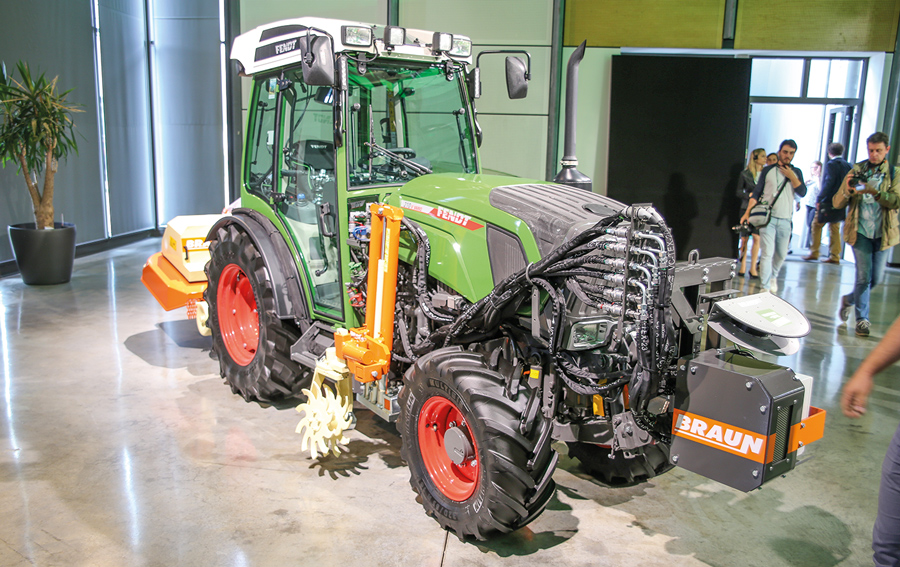
The Fendt 200 Vario with automatic control of complex implement combinations was developed in conjunction with Braun.
Added compatibility
Despite its size the new 900-series models can be set up for a wheel-track down to just 60in.
VarioGrip tyre pressure regulation is an option allowing pressure adjustment while driving. The latest version is capable of inflating dual row-crop wheels from the cab.
Fendt Grip Assistant is also available for the new 900-series through the terminal, allowing the user to determine the ideal ballast and tyre pressures at pre-defined operating speeds. It also allows the user to determine optimum working speed and tyre pressures where ballast is already fitted.
For maximum grip a new 750/70R44 2.2m diameter tyre has been developed for the range.
Load-sensing pumps provide 165- or 220-litres hydraulic oil flow capacity. Optional 430-litres/min flow can be specified. Two autonomous axial piston pumps provide the flow; one with 220-litres/min and the other 210-litres/min, mounted either side of the rear transmission housing allowing convenient hose attachment from each side. Fendt explained that the slight difference in pump output is to prevent resonance when the pumps work together for maximum flow. Having two pumps provides greater flexibility in terms of supplying different rates and pressures and with such high flow available, the system complements Fendt’s iD low-speed concept.

The new 314 Vario with 10hp boost available when needed.
Comfort and convenience
Along with the additional connectivity and driver aids, the new 900 Vario series tractors are available with an infotainment system operated from the terminal. As well as improving clarity of telephone calls, additional upgrades include a high-end speaker system.
A new storage area below the cab on the right-hand side provides space for a tool box or 12-litre washing station.
Also new is an in-cab air supply for convenient hose attachment and making it easier to blow clean the cab floor. External mirrors are electrically adjustable including a telescopic arm mount allowing extension from the seat to see around wide trailers or implements, and quick retraction to avoid damage once the trailer is removed.
Improved anti-theft protection includes a safety locking system and combined immobiliser. This uses a coded key, unique to each tractor, for the cab, ignition, bonnet and fuel tank.
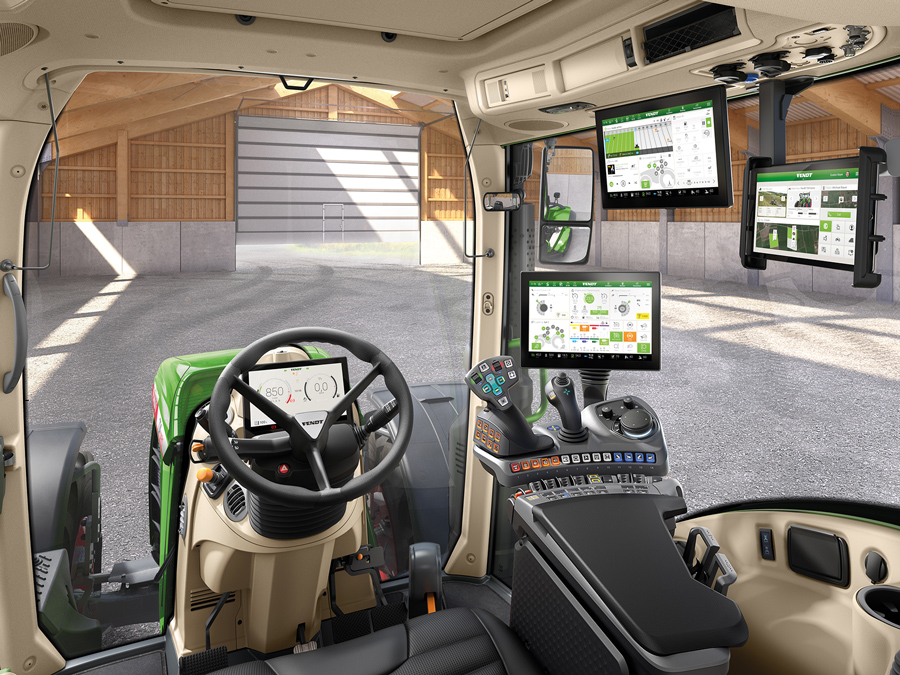
Fendt 700 Vario ProfiPlus models will be the first available with FendtOne making it easier to control multiple implements while making the most of guidance and data sharing through multiple digital displays and the new 3L multi-function joystick.
Task management
Implement control and monitoring can be through the standard Isobus connection. Tractor Implement Management (TIM) is an upgrade option, allowing tractor functions including operating speed to be controlled by the implement.
Fendt TI Headland smart headland management is also available through which Variotronic activation of a programmed headland sequence can be linked to VarioGuide position monitoring. This allows implements to be automatically raised and lowered, for example, when the appropriate headland position is reached.
Deliveries of the new 900 Vario series have already started and most UK dealers have ordered at least one demonstration machine.
The new engine is a significant update, but the integration of the VarioDrive transmission offering improved performance combined with potential fuel and tyre wear savings will also be a major attraction to potential users. In fact, Fendt suggested that its unique drive concept is likely to filter down through to its smaller tractors in time, allowing smaller farms to benefit from the advantages too.
Other tractor news
Other large tractor news includes the flagship 1000 Vario series of which more than 2,000 have been delivered to date. Several new options include those introduced for the new 900 Vario, including; electrically adjustable mirrors with telescopic arm mounts, a security coded key and immobiliser and the infotainment and speaker packages.
The Fendt 900 Vario MT rubber-tracked crawler is now available with the joystick companion to the 10.4in terminal allowing headland sequences to be more easily programmed.
There are also two new hydraulic valve control options.
FendtOne
Looking further to the future a new FendtOne control concept was shown for the first time. Available in late 2020 for the most popular 700 Vario, and 300 Vario series, FendtOne is a new, intuitive operating system which allows users to plan work and field data in the farm office then transfer it direct to the tractor by mobile network with both ends of the process sharing similar layout and appearance for ease of use.
For ProfiPlus models it offers Smart Farming applications such as tracking capability, the Fendt Task Manager for efficient task management and Guide Sync for field data management. The FendtOne platform can be tailored to suit individual situations helping users get the best from their machines. The Agrirouter data exchange platform is a key part of the system making it ideal for contractors to share data with customers using a variety of different farm management programmes and software.
The most noticeable difference between current models and those equipped with the FendtOne system is additional display space and increased display options. Up to three displays can be added within the standard configuration all linked to a central computer. These include a new 9in digital dashboard display which provides essential road travel and Fendt Guide features with operation through an armrest-mounted push-dial. Two 12in displays; one on the right armrest as well as an optional terminal in the roof offer up to 6 freely configurable display fields. Both 12in screens can be controlled through the new, optional 3L multi-function joystick which also incorporates additional functions, or by direct touch to the screens. The new joystick is to the right of the standard crossgate control joystick and has 3 operating levels and up to 27 functions.
Functions are divided into groups by colour making it easy for operators to tell if buttons have been re-assigned and to avoid errors.
Fendt says the improved display options and additional screen area will help operators get the most benefit from the ever increasing number of terminal applications available, and make it easier to handle data and control more complex attachments by providing a better overview of tasks without constantly switching screen views or having to divide screens into smaller sections.
Isobus connectivity is improved including a front connector making it easier to control and monitor front-mounted implements direct from the tractor armrest.
Like the larger tractor series, the new 700 Vario will be available with an optional infotainment and high performance speaker package.
New 300 Vario flagship
Smaller tractors haven’t been forgotten in the upgrades for 2020 and the addition of a new flagship 314 Vario to the 300 Vario series provides an additional 10hp available on-demand through Fendt’s DynamicPerformnce power-boost. DynamicPerformance isn’t restricted only to particular operating situations, so up to 152hp is available whenever it is needed to meet demand for PTO, hydraulics, engine cooling, and air conditioning. It constantly monitors the power requirement, delivering extra if needed. This makes it available for stationary PTO work for example, such as powering large mixer wagons as well as for transport and field work.
FendtOne for the 314 Vario introduces Agrirouter to the series for communication and data exchange and a new multi-function joystick is available offering similar advantages to the new 700 Vario’s system.
The three-terminal option including a 9in, and two 12in displays is similar to the top-end system from the 700 Vario.
A high-end infotainment and speaker system can also be specified.
The new 314 Vario will be available in Profi and ProfiPlus variants in late 2020.
Automated operation
Combined automatic control of Fendt 200 Vario tractors and complex vineyard implements is being introduced by Fendt which has worked with Braun on the development.
The initial system is designed for viticulture where increased mechanical weed control is replacing herbicides. The tractor and implement combination is fully controlled by the system from accurate steering between vine rows to precise positioning and movement of front, rear and mid-mounted implements with operating speed also regulated automatically to suit the task and working environment.
Information from which operational adjustments are decided is provided by a laser, a gyroscope, the Vineyard Pilot Assistant control unit and a terminal.
The laser constantly scans the environment detecting soil contours, vines and stakes and active intervention is only needed from the driver at the headland. Operating speed is almost twice that possible when similar combinations are controlled manually and with more activities combined in one pass, compaction through additional journeys is reduced.
Ideal 10

For 2021 the Ideal 10 will be available with headers up to 12.2m, and no steering wheel.
Fendt’s Ideal combines are working commercially for the first time in the UK this year after a limited number of machines were demonstrated by selected dealers in 2018. So far Ideal 7-, 8- and 9-series models have been shown but an Ideal 10 with a new MAN 16.2-litre power unit producing up to 790hp will be available to order from July 2020 for delivery in time for the 2021 harvest.
The Ideal 10 has a new cleaning system working with the innovative Dual Helix separator. An unusual design feature of the Ideal 10 is that it has no steering wheel, improving forward visibility to the road and the header. Replacing the steering wheel is a steering joystick on the left-hand armrest, and for access to the seat the armrest and joystick fold up out of the way. Fendt IdealDrive joystick steering is said to comply with all traffic regulations and is only available for Ideal combines.
Katana 650
News regarding Katana forage harvesters included an upgrade to the 650 improving performnce and reliability.
Engine power is up by 25hp to 650hp from its MTU 6-cyl power unit. A variable drive cooling fan with reversing function is now standard controlling air flow by adjusting the blade angle.
For harvesters working with wider maize headers, improved performance on undulating ground is provided by a new intake with up to +/- 7 degrees of rotation available.
The crop pick-up is optimised and the processing area is enlarged with two 300mm rollers, one of which has an additional V helical groove to increase lateral destruction of the crop.
The spout has a larger cross section aiding crop flow and Fendt national sales manager Martin Hamer explained that this improves performance in wet grass and will increase appeal for UK users.
From in-feed to the chute flap the redesigned crop flow to suit the new roller conditioner increases throughput by up to 21 per cent, equivalent to 12 per cent reduced fuel use compared with current model performance. Chop length up to 30mm can be obtained.
“For crops such as direct cut rye the new roller cracker can be set up for exceptional cracking quality, and will increase appeal to UK farmers and contractors,” pointed out Martin.
Improved blade sharpening performance and an extended blade and sharpening stone life result from a new sharpening system. The stone constantly readjusts during use and is more aggressive on the outer blade sections to maintain an even profile. Optimal blade sharpening improves chopping quality and extends the service life of the stone and knives by up to 25 per cent claims the company.
For improved performance on steep slopes Fendt has added BalancedGrip to the Katana 650 which adjusts the proportion of drive allocated to each axle and prevents the wheels spinning when axle loads are reduced, protecting the sward from damage.
The new Katana 650 is available to order from November 2019.
Sprayer news
A more powerful Rogator 600 self-propelled sprayer is being added to the line-up. The Rogator 665 has a 307hp, 7.4-litre 6-cyl engine and, from 2020, all Rogator 600 models will be powered by similar power units with a range of different power outputs.
Fendt OptiNozzle will be available from January 2020 offering Rogator users optimal application results with minimum chemical drift. The most suitable nozzle or nozzle combination is automatically selected once the operator has specified the output, degree of drift reduction needed and a working pressure range for optimal droplet size. Then the system constantly adjusts in work responding to changes in speed or output levels.
For Rogator 300 trailed sprayers, Tractor Implement Management (TIM) is being added allowing compatible Fendt Vario tractors to be controlled by the sprayers. The sprayer automatically selects optimal speed and adjusts the nozzle parameters accordingly, including the preferred drift reduction and output. Depending on the nozzles used the sprayer adjusts the travel speed to the calculated target speed ensuring the product being applied always benefits from a suitable level of drift reduction. Active TIM control allows the operator to adjust the speed; choosing from pre-set ranges and the selected speed is maintained while the sprayer adapts the nozzle or combination of nozzles to suit.
Also new for Rogator 300 trailed sprayers is a wider 36m boom with triple folding.
Grass harvest updates
A new front mower is being added to the Fendt Slicer range. The Slicer FQ is designed for medium to large dairy farms and contractors in 3.1 and 3.6m working widths and with tine or roller conditioners. Lateral shift of +/-20cm left and right is standard and allows correction on side-slopes for drift.
Three-dimensional ground adjustment maintains accurate ground following laterally and longitudinally. As the cutter bed moves up and down following ground contours, the mower tilt automatically adjusts between -6 and +15 degrees with the mower’s vertical travel. This is claimed to result in constant cutting height even in difficult conditions. Compensation for undulating ground includes up to +/-13 degrees cross-swing and 750mm vertical travel.
The mower can attach direct to the tractor’s front linkage, keeping the centre of gravity close to the tractor.
Fendt’s TurboLift hydropneumatic ground pressure adjustment is standard with tool-free adjustment and minimises sward damage even in very wet conditions.
The addition of Lotus tedders to the Fendt grass harvesting line-up for next year was welcomed by the Fendt UK sales team. “The Lotus name is highly respected and there is nothing to touch it for tedding performnce in typical challenging UK conditions,” explained Martin, who said having it available for next year’s grass harvest season will be appreciated by customers and dealers.
Three Lotus models in the Fendt range cater for most UK demand. These include the fully mounted Lotus 7.7m 770, and trailed 10.2m 1020T and 12.5m 1250T models. All have Fendt performance tines; 6 on each rotor on mounted models and 7 on trailed. The tines have a unique profile guaranteeing thorough pick-up of the mowed crop and ability to effectively turn heavy, wet forage. Fendt’s tine design is claimed to result in up to 15 per cent higher work rate than standard tines.
Baler updates include Intelligent Hay, allowing data specific to each bale to be recorded and stored easily. During baling, data about each square bale is recorded including GPS position, moisture, bale flakes as well as information regarding bale length, weight and additives used. Using special twine in the third or fourth twine position, an RFID chip is woven into each bale providing an identification code. When this code is cross-referenced against data stored in a cloud-based memory the bale data is available to view.
Other baler news includes the ProCut cutter unit being added as an option for the Fendt Squadra high-performnce square baler. The 26 knives are arranged in the drawer in 2 groups, each of which can be controlled separately to provide a fine cut or for double the cutting length when only half are selected.

Lotus tedders are a welcome addition to Fendt’s green harvest range.
